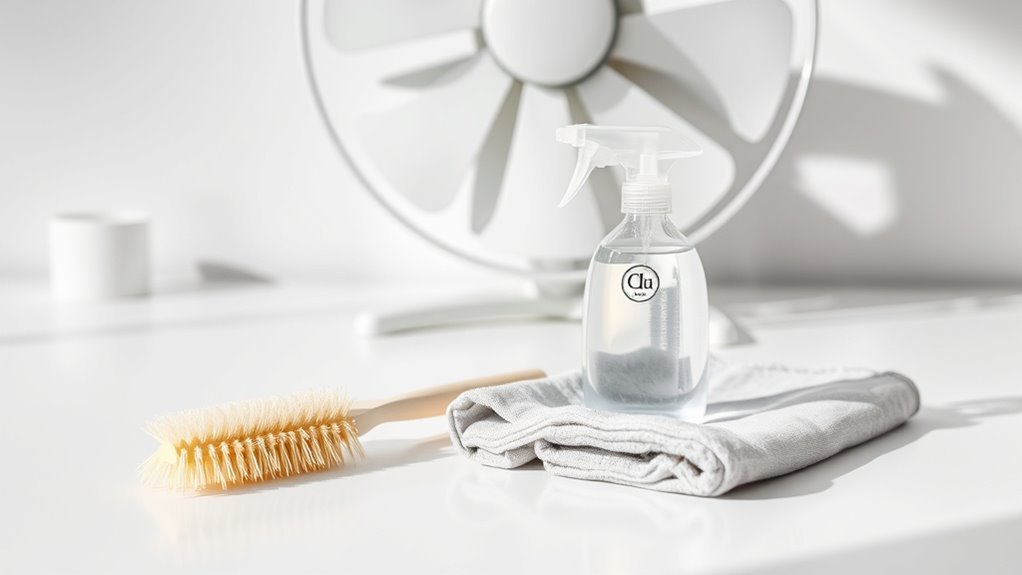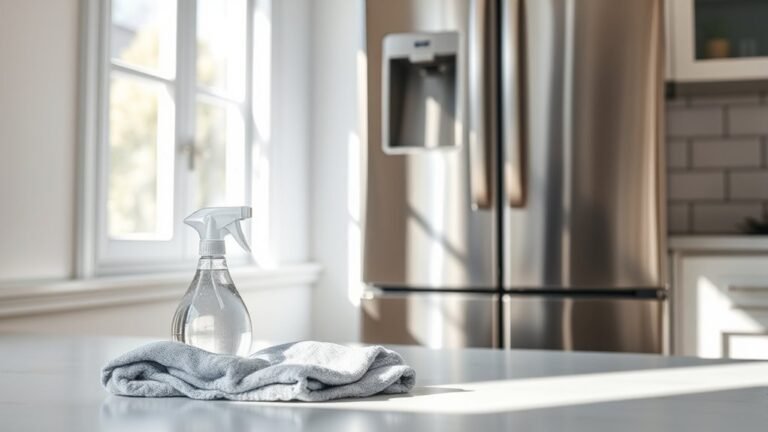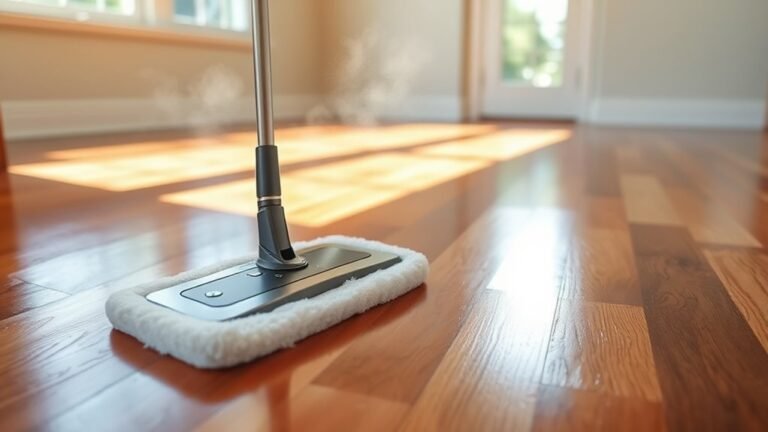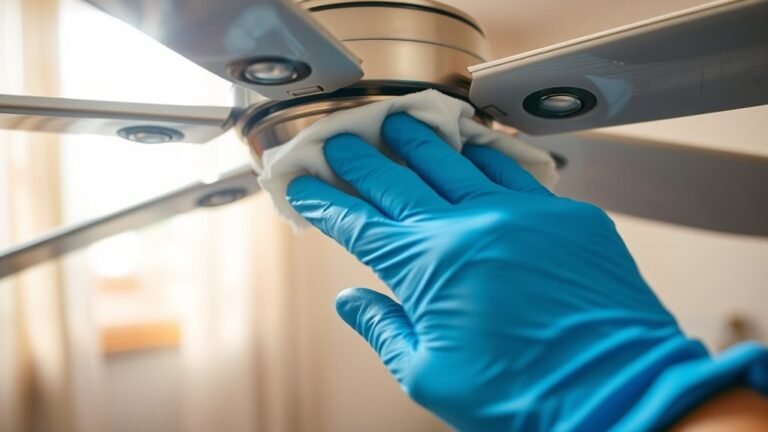How to Clean and Deodorize Your Fan
To clean and deodorize your fan, unplug it first, then carefully remove the front grill and blades using a screwdriver. Wipe blades and grills with a microfiber cloth dampened in mild detergent, and use a soft brush or compressed air for hard-to-reach spots. Dry thoroughly to prevent mold. For deodorizing, apply baking soda or essential oils near the intake, avoiding moving parts. Regular cleaning every two weeks keeps odors and dust at bay. Detailed guidance on each step can help you maintain peak fan performance.
Tools and Materials Needed for Fan Cleaning

To effectively clean and deodorize your fan, you’ll need a precise set of tools and materials designed for the task. Start with essential cleaning supplies: a soft microfiber cloth to prevent scratches, a small brush or compressed air canister to remove dust from tight spaces, and mild detergent or specialized fan cleaner for grime buildup. Gloves protect your hands during cleaning. For fan maintenance, have a screwdriver ready to access internal components if needed, along with lubricating oil to guarantee smooth motor operation. Avoid harsh chemicals that might damage plastic or metal parts. Having a shallow basin or container for soaking detachable grill parts can help loosen stubborn dirt. These carefully selected tools empower you to maintain your fan’s efficiency and longevity while enjoying the freedom of fresh, clean airflow.
Step-by-Step Guide to Disassembling Your Fan
Having gathered the necessary tools and materials, you can begin disassembling your fan to access all areas for thorough cleaning. First, unplug the fan and verify it’s completely powered off—safety precautions are paramount. Remove the front grill by unscrewing or unclipping it, depending on your fan assembly design. Next, carefully detach the fan blades by loosening the central nut or release mechanism. Keep track of all screws and small parts to avoid misplacement. Then, remove the rear grill if applicable, exposing the motor housing. Avoid forcing components to prevent damage. Your goal is to dismantle the fan just enough to clean each part thoroughly without compromising structural integrity. Follow this methodical approach, keeping your workspace organized, so reassembly is straightforward and your fan functions efficiently afterward.
Effective Methods for Cleaning Fan Blades and Grills

Although fan blades and grills may seem straightforward to clean, their shape and material require specific techniques to remove dust and grime effectively without causing damage. For fan blade cleaning, use a microfiber cloth dampened with mild detergent; avoid soaking to prevent motor issues. For grill cleaning techniques, a soft brush or compressed air helps dislodge dirt from tight spaces.
| Task | Tool Needed | Emotion Evoked |
|---|---|---|
| Fan Blade Cleaning | Microfiber cloth | Satisfaction |
| Grill Dust Removal | Soft brush | Relief |
| Deep Cleaning | Mild detergent | Confidence |
| Drying & Reassembly | Soft towel | Freedom |
Mastering these guarantees your fan runs cleanly, quietly, and efficiently—letting you enjoy fresh airflow without hassle.
Techniques to Deodorize Your Fan Naturally
Once your fan blades and grills are spotless, addressing lingering odors becomes the next priority to guarantee prime air quality. Start by sprinkling a thin layer of baking soda on a damp cloth and wiping down all accessible fan surfaces; baking soda’s porous structure absorbs odors effectively without harsh chemicals. For enhanced freshness, add 10–15 drops of essential oils like lavender or eucalyptus onto a cotton ball, then place it near the fan’s air intake or motor housing, ensuring it doesn’t interfere with moving parts. The fan’s airflow will distribute the natural scent evenly, masking residual smells and promoting a clean atmosphere. These techniques provide a safe, chemical-free deodorizing process that preserves your freedom from synthetic fragrances while maintaining peak fan performance.
Tips for Regular Maintenance and Preventing Odors

Regular maintenance is essential to keep your fan running efficiently and odor-free. Establish a frequency cleaning schedule—ideally every two weeks—to remove dust buildup on blades and grills, which are primary odor sources. Use a soft cloth dampened with mild detergent to clean surfaces without damaging components. For odor prevention, make sure the fan is completely dry before reassembly to prevent mold growth. Additionally, inspect and clean the motor housing and vents monthly; trapped dust here can emit stale odors and reduce airflow. Avoid using strong chemical cleaners that can leave residue and exacerbate odors. By adhering to these practical steps, you maintain peak performance and enjoy fresh airflow, granting you the freedom to use your fan without unpleasant smells or mechanical issues.
Frequently Asked Questions
Can Using a Fan Cause Allergies or Respiratory Issues?
Using a fan can impact your respiratory health if it circulates fan allergens like dust, mold spores, or pet dander. These allergens can irritate your airways, triggering allergies or respiratory issues, especially if you’re sensitive. To protect yourself, make certain your fan is regularly cleaned and filters are replaced if applicable. Maintaining a clean fan helps minimize allergen buildup, allowing you to enjoy fresh air without compromising your respiratory freedom.
How Often Should I Replace My Fan Instead of Cleaning It?
Back in the days of the telegraph, folks replaced gadgets only when they truly wore out. For your fan, consider its fan lifespan—typically 5 to 10 years. If you clean it regularly, say every 1 to 3 months, and it still hums smoothly without strange noises or decreased airflow, you can keep it longer. But if performance drops or parts wear out, it’s smarter to replace it, ensuring fresh air freedom and efficiency.
Are There Specific Fan Types That Are Easier to Clean?
When it comes to ease of cleaning, box fans are generally simpler because their grill and blades often detach easily, letting you access all parts without hassle. Ceiling fans can be trickier due to their height and multiple blades, but models with removable blades or quick-release mechanisms make the job less intimidating. Choosing fans designed for easy disassembly gives you more freedom and efficiency in maintenance, saving time while keeping your space fresh.
Can Fans Spread Bacteria or Viruses in a Room?
Yes, fans can contribute to bacteria transmission by circulating airborne particles, including microbes. While virus survival on surfaces varies, fans don’t kill viruses; instead, they can disperse virus-laden droplets across a room. To minimize risks, you should guarantee good ventilation, regularly clean your fan to reduce dust and microbial buildup, and consider using air purifiers. Taking these steps helps maintain your freedom to breathe cleaner air without unnecessary bacterial or viral spread.
Is It Safe to Use Commercial Air Fresheners on Fans?
Using commercial air fresheners on fans isn’t always safe. They can leave residue on fan blades, complicating fan maintenance and potentially reducing efficiency. Additionally, some air fresheners release chemicals that may worsen indoor air quality, especially if you’re sensitive or have allergies. Instead, focus on regular cleaning and using natural deodorizing methods to maintain fresh air without compromising your fan’s performance or your freedom to breathe clean, healthy air.






